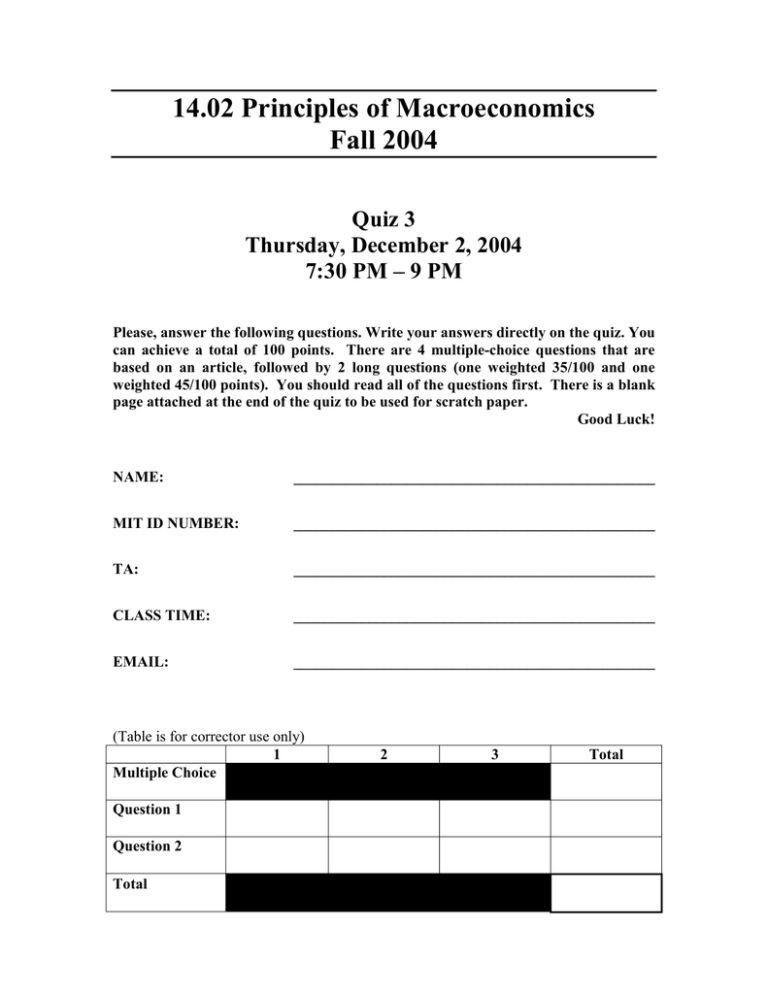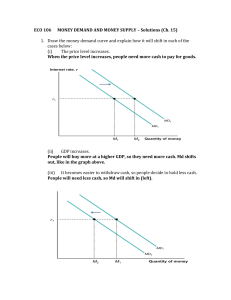Document 13569844
advertisement

14.02 Principles of Macroeconomics Fall 2004 Quiz 3 Thursday, December 2, 2004 7:30 PM – 9 PM Please, answer the following questions. Write your answers directly on the quiz. You can achieve a total of 100 points. There are 4 multiple-choice questions that are based on an article, followed by 2 long questions (one weighted 35/100 and one weighted 45/100 points). You should read all of the questions first. There is a blank page attached at the end of the quiz to be used for scratch paper. Good Luck! NAME: ________________________________________________ MIT ID NUMBER: ________________________________________________ TA: ________________________________________________ CLASS TIME: ________________________________________________ EMAIL: ________________________________________________ (Table is for corrector use only) 1 Multiple Choice Question 1 Question 2 Total 2 3 Total Multiple-Choice Questions (20/100 points) Please, circle the correct answer for each of the following 4 multiple-choice questions that are based on the article provided below. For each question, only one of the answers is correct. Each question counts 5/100 points. Investors in Treasuries Grow More Bearish Before Jobs Report Nov. 29 (Adapted from Bloomberg) – Investors in US government bonds became less optimistic last week on speculation a government report will show November employment improved enough to keep the Federal Reserve from slowing the pace of interest rate increases. The price of a 10-year bond has fallen every week since the government said Nov. 5 that more jobs were created in October than any month since March. Big Event A Bloomberg News survey last week showed that most experts expected the Fed to raise the target rate for overnight loans between banks to 2.25 percent from 2 percent on Dec. 14. A month ago, only a few forecast an increase in the federal funds rate. Tame Inflation A decline of the dollar and the increase in oil prices haven’t caused a “significant change” in the inflation outlook. Demand for US government bonds may also weaken on concern foreign central banks and investors will cut their holdings of U.S. securities as the dollar falls. The dollar weakened 3.90 percent against the euro and 3.14 percent against the yen this month. It traded at a record low of $1.3329 per euro on Friday. China Scare Fed Chairman Alan Greenspan said on Nov. 19 at the European Banking Congress in Frankfurt that a record U.S. current account deficit will cause foreign investors to demand higher rates on U.S. securities. US government bonds fell on Nov. 26 after China Business News reported Yu Yongding, a Chinese central bank official, said China had cut its holdings of U.S. debt. Later, the official said the report was “distorted.” China's central bank declined to comment. 2 1) According to the article, what is the main reason investors in US government bonds grow less optimistic? A) They are concerned about the decline (depreciation) of the dollar, which, in the long run, leads to an increase in the price level. B) They are expecting high inflation due to rising oil prices, which would lead to a fall in real interest rates in the future, despite the Fed’s tightening. C) Because the Fed is in “tightening mode,” due to reports of higher job creation and evidence of low inflation, and thus they expect the price of bonds to decrease. D) Because the Fed is in “tightening mode,” due to reports of higher job creation and evidence of low inflation, and thus they expect the price of bonds to increase. E) Both A) and D). 2) The report says that “A Bloomberg News survey last week showed that most experts expected the Fed to raise the target level for overnight loans between banks to 2.25 percent from 2 percent on Dec. 14. A month ago, only a few forecast an increase in the federal funds rate.” This information implies the valuation of any assets (hint: use the formula for EPDV discussed in class and assume nothing else changes in reaction to what the Fed does): A) B) C) D) E) Will decrease on Dec. 14 if the Fed increases the target level to 2.25 percent. Will decrease on Dec. 14 if the Fed raises the target level to 2.50 percent. Have decreased from last month to today. Both A) and C). Both B) and C). 3) The article reports that the dollar weakened 3.9% against the euro over the last month. If the dollar continues to weaken, we should expect (assume that the Marshall-Lerner condition holds) A) B) C) D) E) Exports from the US to Europe to increase. US imports from Europe to increase. The US trade balance with Europe to deteriorate. Both A) and C). Both B) and C). 3 4) The article mentions the“China Scare,” stating that “US government bonds fell on Nov. 26 after China Business News reported Yu Yongding, a Chinese central bank official, said China had cut its holdings of U.S. debt.” Why did the price of US government bonds fall as a reaction to the news from China? A) The demand for dollars declined which has to lead to an increase in current US interest rates. B) The demand for dollars declined which has to lead to an increase in current and future US interest rates. C) US interest rates are expected to rise to prevent the US from running into problems with financing its trade deficit. D) The Fed will have to raise interest rates to prevent the US government from selling its bonds. E) Bankers in New York were worried that the report was actually distorted which leads to uncertainty about the true demand for dollars. 4 Long Question I (35/100 points) Open Economy AS-AD and Growth Assume that the economy is described by the following set of equations. Exchange rate: E= E Wage Setting: ⎛ W ⎞ P = (1+ µ ) ⎜ ⎟ ⎝ A ⎠ e e W = P A F(u,z) AD: Y= C(Y, T) + I (Y,i) + G + NX (Y, Y*, ε ) Price Setting: Assume that the Marshall-Learner Condition is satisfied. 1. Suppose the economy is at a place where u < uN (point Q). Assume that A and Ae are constant. Without fiscal policy and monetary policy interventions, what happens over time? Show graphically. Label all curves. Label the medium-run equilibrium as point M clearly. (5 points) i i LM0 Q i0 IS0 YN Y0 Y E E P AS0 P0 Q AD0 0000 YN Y0 Y 5 YN 2. If the central bank announces a one-time revaluation of its currency that is credible, what happens over time? Still, assume that A and Ae are constant. Show graphically. Label all curves. Label the medium-run equilibrium as point M clearly. (7 points) i i LM0 Q i0 IS0 YN Y0 Y E E P AS0 P0 Q AD0 0000 YN Y0 Y 6 YN 3. What is the advantage of government intervention, namely one-time revaluation of the domestic currency in question 2, if the speed of adjustment from point Q to the medium-run equilibrium was the same as in question 1? Limit your answers to a few sentences. (7 points) 4. Now, the economy is at the medium/long-run equilibrium (point M) but it experiences an increase in productivity. What happens to its natural rate of unemployment if people’s expectations about prices and productivity are correct? Why? Show graphically. Label all curves. (5 points) W P u 7 5. As in question 4, the economy is at the medium-run equilibrium (point M), but it experiences an increase in productivity which does not affect AD. If people’s expectations about productivity are always correct, what happens in the short- and medium-run? Show graphically. Label all curves. Label short- and medium-run equilibria clearly. (11 points) (hint: u = 1 – Y/AL) i LM0 i M i0 IS0 Y1N P P0 Y E E AS0 M AD0 0000 Y1N Y 8 YN Long Question II (45/100 points) Growth The Republic of Solowakia has the following production function: α 1−α Yt = F ( K t , N t ) = At K t N t , where α<1. Assume for now that At is constant over time (there is no technological progress in this economy, so At=A), gN is the growth rate of N, δ is the rate of depreciation in this economy, and s is the saving rate. 1. Verify that the above production function has the property of constant returns to scale and rewrite the production function in terms of only capital per worker. (Define K Y k t = t and y t = t .) (5 points) Nt N t 9 2. Solve for the steady state values of capital per worker (k*), output per worker (y*), and consumption per worker (c*). Draw a diagram that shows all three steady state values you calculated. (6 points) y k 10 3. Find the saving rate at which steady-state consumption is maximized (i.e. we are at the Golden Rule steady state). (7 points) 4. Suppose that at time t there is a one-time inflow of foreign workers into the country, so that N jumps from N0 to N1. (Assume that this does not affect gN.) Draw two diagrams: one showing what happens to the investment and required investment schedules, including dynamics, and one depicting the effects of this inflow on capital per worker over time. (7 points) y k 11 k time 5. Suppose Solowakia (S) and Macronesia (M) have identical production functions and same δ, gN, and s. However, AS>AM. Which country will have a higher steady-state capital per worker? Prove your answer mathematically and with a diagram. (7 points) y k 12 6. Assume that all countries are heading towards the same steady state (that is, in the long run, all countries have access to the same technology and have the same preferences as manifested in the same saving rate and population growth rate). Does the model predict growth for poorer countries should be faster, slower, or the same as richer countries? Show mathematically. (Hint: Define the growth rate of capital ∆k as g K = t .) (7 points) kt 13 7. Suppose that α=0.5 in the given production function. Assume that the level of technology in the country depends on capital per worker, in particular A=kβ. Discuss convergence and growth in an economy with β=0.5 and compare it to an economy with β<0.5. Use diagrams and words. (6 points) 14 15





